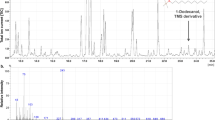Summary
Spent media from five different insect cell lines when inoculated intoTrichoplusia ni (TN-368) cultures produced cytotoxicity resulting in rounding and detachment of cells. The substance in spent medium from the established cell lineCarpocapsa pomonella (CP-169) is believed to be a toxin, based on the failure to serially passage the agent, the early appearance of the cytotoxic effect, and the inability to detect microbes by culturing techniques as well as by electron microscopy. The ability to extract the toxic substance from CP-169 cells indicates that it is cell associated. Biophysical and biochemical properties of the CP-169 cytotoxin are presented.
Similar content being viewed by others
References
Katsuta, H., T. Takaoka, and Y. Nagai. 1966. Interaction in culture between normal and tumor cells of rats. In: H. Katsuta (Ed.),Cancer Cells in Culture. U. of Tokyo Press, Tokyo, and University Park Press, Baltimore and State College, Pa., pp. 164–166.
Elson, C., R. P. Geyer, and R. S. Chang. 1970. A Lecithinase from the amoebaHartmanella rhysodes. J. Protozool. 17: 440–445.
Rechtoris, C., and A. H. McIntosh. 1975. A toxic factor from the established cell line CP-169 (Hink):Carpocapsa pomonella (Lepidoptera: Olethreutidae). J. N. Y. Ent. Soc. 83: 271.
Hink, W. F. 1970. Established insect cell line from the cabbage looper,Tricoplusia ni. Nature 226: 466–467.
McIntosh, A. H., K. Maramorosch, and C. Rechtoris. 1973. Adaptation of an insect cell line (Agallia constricta) in a mammalian cell culture medium. In Vitro 8: 375–378.
McIntosh, A. H., and C. Rechtoris. 1974. Insect cells: colony formation and cloning in agar medium. In Vitro 10:1–5.
McIntosh, A. H. 1976. Agar suspension culture for the cloning of invertebrate cells. In: K. Maramorosch (Ed.),Invertebrate Tissue Culture: Research Applications. Academic Press, New York. pp. 3–12.
Reed, L. J., and H. Muench. 1938. A simple method of estimating fifty percent endpoints. Am. J. of Hygiene 27: 493–497.
Hink, W. F., and B. J. Ellis. 1971. Establishment and characterization of two new cell lines (CP-1268 and CP-169) from the codling moth,Carpocapsa pomonella (with a review of culture of cells and tissues from Lepidoptera). Curr. Top. Microbiol. Immunol. 55: 19–28.
Goodwin, R. H., J. L. Vaughn, J. R. Adams, and S. J. Louloudes. 1970. Replication of a nuclear polyhedrosis virus in an established insect cell line. J. Invertebr. Pathol. 16: 284–288.
Chiu, R. J., and L. M. Black. 1967. Monolayer cultures of insect cell lines and their inoculation with a plant virus. Nature 215: 1076–1078.
Nakajima, S., and T. Miyake. 1976. Effective colony formation inDrosophila cell lines using conditioned medium. In: E. Kurstak and K. Maramorosch (Eds.), Invertebrate Tissue Culture: Applications in Medicine, Biology, and Agriculture. Academic Press, New York, pp. 279–287.
Author information
Authors and Affiliations
Rights and permissions
About this article
Cite this article
Rechtoris, C., McIntosh, A.H. A cytotoxic substance in insect cell culture spent media. In Vitro Cell.Dev.Biol.-Plant 12, 678–681 (1976). https://doi.org/10.1007/BF02797470
Issue Date:
DOI: https://doi.org/10.1007/BF02797470




